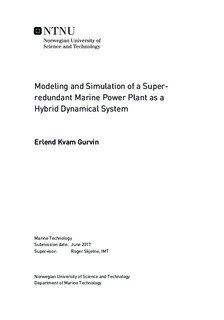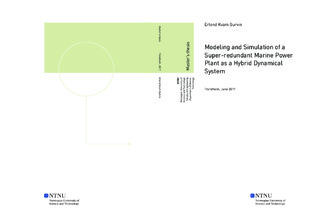| dc.description.abstract | During the last years the maritime industry has experienced increased demands in energy efficient and low emission vessels with high reliability and availability. These demands have been a motivation for electrical powered vessels with smarter power management systems. A diesel electric marine propulsion system converts power produced by diesel engines to electric power, which is distributed to the on-board consumers. Diesel electric propulsion offers more flexibility as the power plant consists of multiple diesel engine and generator pairs, called gensets. Diesel electric propulsion is especially efficient during operations with varying power demand, such as dynamical positioning.
A super-redundant marine power plant consists of many small gensets, up to thirty, while a conventional diesel electric marine power plant consist of four larger gensets. Diesel engines are the most fuel-efficient while operating at about 80% of their rated power. By increasing the number of engines making up a marine power plant, the engines would run at their most fuel-efficient power for a larger portion
of operations. However, smaller engines are generally less efficient than larger ones. The thesis considers if there are any benefits in using a super-redundant marine power plant.
A model describing both mechanical and electrical aspects of a marine power plant is developed based on hybrid dynamical system theory. This allows the modeling of both the continuous and discrete changes of states in the power plant. The model is designed with a load control strategy which connects and disconnects gensets to the electrical grid based on the power consumption and a start/stop table. The model is shown to successfully connect and disconnect gensets with the synchronization and ramping that is necessary to do so, and provide equal load sharing among the active gensets.
A case study shows how a conventional four-genset marine power plant configuration outperforms a ten-genset configuration at loads above half the total capacity, while at lower loads the difference is negligible. The start/stop table in the case study were not properly tuned for the gensets, resulting in the super-redundant power plant not operating at optimal loading conditions. Considering a properly tuned start/stop table, the ten-genset marine power plant could potentially reduce fuel consumption with up to 4% compared to that of the case study, this would suggest that a super-redundant marine power plant is more efficient than conventional configurations, especially while operating below 50% of the power plants total power capacity.
There are potential savings in maintenance for vessels with super-redundant power plants that often visit the same port. Due to the gensets relatively small size, a faulty genset could be swapped with a functioning one at port, reducing costly maintenance and downtime at sea. Redundancy would be greatly improved by increasing the number of gensets, as a single fault would have a significantly smaller impact on the total power output of the power plant.
With potential savings on fuel consumption, emissions, maintenance, and an increased redundancy, a super-redundant marine power plant could become commercially viable and contribute to reduce emissions from maritime industry. | |

